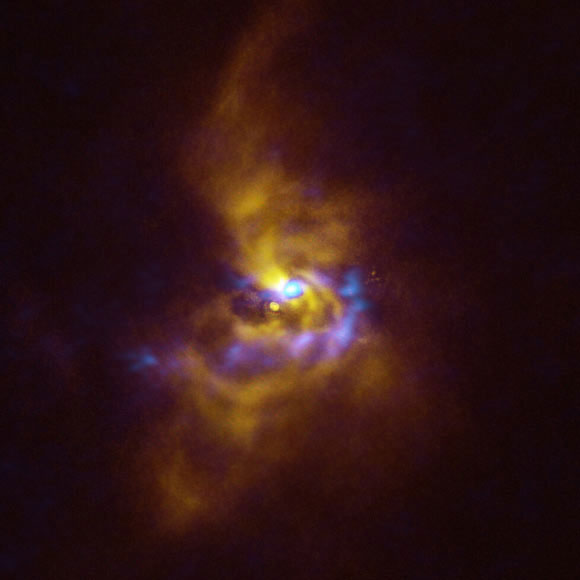Image of 'once in a millennium' space object released
While tracking a star in the constellation of Cygnus, scientists were 'dazzled' by a sudden increase in light of up to 20 times due to the appearance of unique objects.
According to Sci-News , an international team of scientists was monitoring a star named V960 Mon in the constellation of the Unicorn , 5,000 light years from Earth, when they encountered the "blinding" event mentioned above in 2014.
Convinced they had caught something strange, they enlisted the power of the world's leading observatories to continue monitoring the object for years in an attempt to find answers.

The bizarre, chaotic thing that the two observatories observed was planets in the moment of birth - (Photo: ESO/ALMA).
Using the SPHERE instrument on the European Southern Observatory's (ESO) Very Large Telescope , they discovered a mysterious collection of complex spiral arms around V960 Mon , extending over distances greater than the diameter of the Solar System.
Calling for help from ALMA , the world's most powerful radio telescope array located in Chile's Atacama Desert, they found that these spiral arms were in the process of fragmentation, leading to the formation of strange masses.
There is only one answer that fits all the data. And it is a "once in a lifetime" moment in astronomical observation.
"This discovery is really exciting because it marks the first detection of clumps around a young star that are capable of forming giant planets ," said Associate Professor Alice Zurlo from Diego Portales University (Chile).
It is also the first observation of gravitational instability at the planetary scale, says lead author Philipp Weber, also from Diego Portales University.
That means the object astronomers are seeing is a protoplanet at the very moment of its birth: The material around the young star will eventually collapse and collapse, and from there, a planet will gradually accrete.
"The size of these still-converging looming clumps suggests that future planets must be as large as Jupiter - the largest planet in the Solar System," said the article published in the scientific journal The Astrophysical Journal Letters .
- NASA: The millennium challenges
- Admire the image of the 5,250km2 wide artificial lake seen from space
- 'Time travel' 13 billion years, strange object reveals how the universe began
- Video: See the Millennium Falcon spaceship in real life
- Korea announced the image of Earth taken from space
- The surprising truth about the image of 'ghost butterfly' flying through space was captured by the observatory
- 2008 Millennium Technology Award for Americans
- Video: Summarizing the earth image for 3 years from ISS station
- Russia solves the object 'E' to explore the Moon
- Spectacular beautiful images of the Earth taken from MSG-4 satellites
- UFO hovering near the International Space Station?
- Confusing photos of volcanoes from space
 Van Allen's belt and evidence that the Apollo 11 mission to the Moon was myth
Van Allen's belt and evidence that the Apollo 11 mission to the Moon was myth The levels of civilization in the universe (Kardashev scale)
The levels of civilization in the universe (Kardashev scale) Today Mars, the sun and the Earth are aligned
Today Mars, the sun and the Earth are aligned The Amazon owner announced a secret plan to build a space base for thousands of people
The Amazon owner announced a secret plan to build a space base for thousands of people